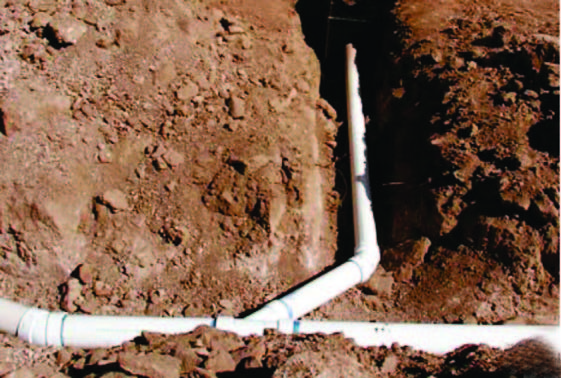The PermaDesign Weblog, with Nate Downey and Melissa McDonald!
Roof-Reliant Landscaping™ Step 16D: Water Conveyance - Horizontal Run

Figure 8-8: Conveyance pipes being installed, which will carry water to a cistern.
Almost all cistern systems require conveyance pipes that run perpendicular to the system's verticaldrop line. To maintain positive drainage toward the cistern, however, these pipes only appear to be horizontal and, in fact, must not be level. The horizontal runs should drop a minimum of onequarter inch per linear foot until they connect with your storage area.
There are two kinds of horizontal runs: aboveground pipes and underground pipes. Aboveground runs are generally associated with aboveground and partially buried cisterns. Underground runs are typically used with underground cisterns.
Horizontal runs should be installed at least three feet away from any building or wall. Assuming sufficient depths and compacted soil between lines, your trenches for these conveyance runs can also be used for other conduits such as drip irrigation tubing and pressurized distribution pipes, as well as low-volt and high-volt electric lines. (Check local building codes to verify required burial depths.)
An important job for every cistern system designer is the proper sizing of the diameter of horizontal run lines. Pipes that are too small will not be able to harvest the entire system’s potential and will cause flooding wherever the flow is constricted by an excess volume of water. Pipes that are too large will cost more money than is necessary for both the materials and labor.
Before installing the pipes, it is critical to determine that there are no buried utilities anywhere in the vicinity of your proposed trenches and that the pipes will not be placed in the way of any other future landscape feature. You are required to call New Mexico One Call (also known as the toll-free Buried Cable Locating Assistance Hotline) at 1-800-321-2537 or New Mexico One Call at 811. Information is also available online at http://www.nmonecall.org to locate existing utilities.
To install an underground horizontal run, complete the following steps:
• Double-check to make sure that there are no utility lines in the vicinity of your trenches.
• Excavate along the lines.
• Lay pipe and fittings with a 1/4” drop per linear foot. Use sanitary tees and other fittings made for drainage. (SDR35 DWV fittings are commonly used in outdoor settings.)
• Connect horizontal run(s) to the vertical-drop point(s).
• Connect horizontal run(s) to the chosen method of prefiltration.
• Connect the final horizontal run to the cistern at the delivery point.• Install cleanouts at every 135-degree or greater bend and at the end of continuous runs.
• Make sure there is a cleanout for every run of more than 100 feet of conveyance pipe.
• Take pictures of the trenches (which include aboveground reference points so you can find the pipes once they are buried). Keep these photos in a file for future reference.
• Backfill and tamp trenches.
Conveyance pipes are typically PVC or ABS plastic pipes. PVC is the most expensive, but it is usually the most durable. ABS, the least expensive horizontal pipe material, is made of a corrugated, flexible plastic material that bends easily around obstacles. This makes the pipe relatively simple to work with. However, ABS is more susceptible to damage than other conveyance materials (it can be punctured with a shovel or a spade), and it has more creases that can collect sediment. Horizontal run piping does not have to be buried below the frost line as pressurized piping does. Conveyance pipes can be placed under the surface of the soil, covered with at least six inches of backfill material. However, conveyance piping along north-facing slopes is prone to freezing, so it is best to bury these runs below the frost line at a minimum of 12 inches deep.
Glue and/or tightly fit all of the pipe connections and install cleanouts for any horizontal runs of more than 100 linear feet. Conveyance pipes that run parallel to the foundation of a structure should be installed at least three feet away from the foundation.
01/25/2016 | (0) Comments










Comments